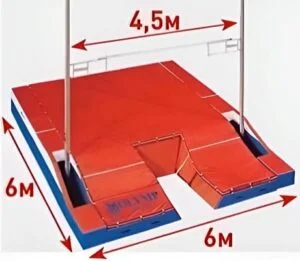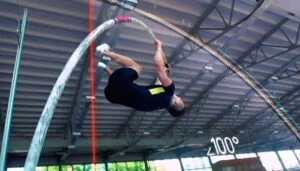In the article “High jumping” we will talk about two athletic disciplines, high jump and pole vault, and talk about the peculiarities.
#HighJump #HighJumping #PoleVault #SummerSport
The roads of ancient man were not paved, but at best were trampled paths by wild beasts. Therefore, there were many obstacles in the way of man, fallen trees, deep holes, wide streams. To learn how to jump over them, was for our ancestors a vital necessity. And they did.
As has happened more than once in the history of mankind, a vital skill gradually became a pastime. The high jump appeared in the Olympic Games at the very beginning of their revival. In 1896 only men competed, and in 1926 women were allowed to compete.
The first competition was held in England in 1864. The Englishman Robert Maitsch won the competition, jumping to a height of 1 meter and 67.4 centimeters. However, Maitsch could not set a world record, because his compatriot Robert Gooch managed to cross the bar at a height of 1 meter and 70 centimeters five years earlier.

The high jump belongs to the technical discipline of vertical jumps. Pole vaulting also belongs to this group. By the way, athletes did not begin to pole vault immediately. For the first time athletes demonstrated such a exercise in England in 1866. In competitions held in medieval Ireland, there were also similar exercises.
The Olympic history of women’s pole vaulting began much later in 2000. The name of the Russian athlete, two-time Olympic champion, holder of 28 world records, Elena Isinbaeva is already written in its history. In 2005, for the first time in the history of women’s pole vaulting, she cleared more than 5 meters.
Pole vaulting and high jump are similar in many ways. The athlete needs to jump over a bar set at a certain height. The rules of these jumps also have a lot in common. Pole vault and high jump take place in designated sectors in which a place is prepared for the run-up, is located bar on holders and a place to land.
At each stage of the competition, preliminary or final, the athlete is given the right to 3 attempts at each height mark. In order for the jump to be valid, the bar must be able to hold on its posts and the athlete does not touch the surface of the sector until he/she passes the bar.

In addition, the bar cannot be held with the hands. If all the rules are met, the judge fixes the jump by raising the white flag. Falling of the bar after fixing the result does not affect the scoring. It happens that in the pole vault does not hold up and breaks the pole. In this case, the athlete may jump again and his attempt is not burned out.
The width or length of the bar for the high jump is 4 meters and for the pole vault is 4.5 meters. The landing area for high jumpers is 3 by 5 meters and for their pole vaulter counterparts is 6 by 6 meters.
In order to perform a successful jump, it is important to accurately perform a certain sequence of actions, which is commonly divided into phases.

There are four phases in total:
1. Run-up;
2. Repulsion from the surface;
3. Transition over the bar;
4. Landing.
Athletes and coaches have been searching for 60 years for the best jumping technique to overcome the bar with the most rational effort. Today, we have more than 10 different options for overcoming the bar. All of them can be divided into groups:
1. Stepping over;
2. Wave;
3. Rolling over;
4. Rolling.
Today, most jumpers use the Fosbury flop technique, where the jumper crosses the bar with his back to the ground. This technique is named after the American jumper Fosbury, who demonstrated it at the Olympic Games in Mexico City in 1968.
The world records for high jump are set separately in outdoor stadiums and indoors, the results differ from each other. The current world record for men is 2.45 meters in a stadium and 2.43 meters indoors. The author of these records is Cuban Javier Sotomayor.
And the best result among women is 2 meters and 9 centimeters in the stadium, and 1 centimeter lower indoors. As for the pole vault, the world records both in the stadium and indoors belong to the Swedish jumper Arman Duplantis and the Russian athlete Yelena Isinbaeva. Arman took off with the pole to the mark of 6 meters and 20 centimeters, and Yelena overcame 5 meters and 6 centimeters.

Part of the glory of modern pole vaulters rightfully belongs to the pole itself. At the beginning of the 20th century poles were made of different types of wood, beech, pine, red cedar. Then lighter bamboo poles replaced them, but bamboo was less strong, so after a while they were replaced by poles made of metal.
And at the Rome Olympics in 1960 a novelty was demonstrated – lightweight and flexible plastic poles. With their appearance, pole vaulting reached new heights. While the ceiling for wooden poles was 4 meters and 77 centimeters, and for metal poles – 4 meters and 82 centimeters, the record for a plastic pole was 6 meters and 20 centimeters.
So what helped athletes achieve such dizzying heights? The answer is a rational use of the potential energy of the pole. Let’s take a closer look at this point.
At the very beginning the athlete runs up, picks up speed. On the last meters of the distance the athlete prepares to push off, i.e. he takes the pole and puts it into the tray and here starts the most interesting thing.
When the poles were not flexible, a shock took place and the kinetic energy of the athlete was used to slightly deform the rigid pole and to push the tip of it into the tray. But the elastic and flexible plastic pole behaves differently.

Under the influence of the kinetic energy of the athlete, it begins to bend, and part of the kinetic energy of the athlete’s movement, which was previously wasted, is transferred to the energy of the elastic pole, this energy is called potential energy. The pole, like a compressed spring, stores energy and then, as it straightens, gives it back to the athlete, helping him to fly as high as possible.
In this way, the potential energy of elasticity again turns into kinetic energy of the athlete, giving him an extra push. That’s why we wrote that the plastic pole deserves some of the laurels that go to the winners.
Yelena Isinbaeva set her records on a fiberglass pole. Fiberglass is fiberglass, it is stronger than aluminum and steel. The bending angle of the pole is 105 degrees. However, some athletes prefer staves made of carbon. Carbon models are lighter and faster, but not very strong.
At the 2010 European Championships, the Russian athlete Dmitry Starodubtsev’s carbon pole broke during a jump. Because of the unfortunate accident, the athlete injured his arm and could not perform adequately in the final tournament.
As practice shows, it is easier to achieve success in high jump and pole vaulting for tall and long-legged athletes with a slender build. When selecting jumps coaches may pay attention to the weight and height of candidates, but it is not mandatory.
Equally important is the overall physical preparation, because jumping is a sport that requires athletes to be collected, well-developed coordination, flexibility and strength. If you decide to dedicate yourself to high jumping, you need to pay a lot of attention to physical activity. Run more, jump more, prepare your body.
Pole vault
FAQs
What is high jumping?
The high jump is a group of vertical jump disciplines in which an athlete must jump over a bar at a certain height, so that it can be held on its struts. At the Olympic Games, high jumps are performed in 4 sports: high jump from the sprint, high jump from the pole vault, heptathlon and decathlon.
Why are world records separated in the stadium and indoors?
The world record at the stadium is affected by the weather (precipitation, temperature, wind). Moreover, the record will be cancelled if the tailwind speed is higher than 2 m/sec. The size of the running tracks also affects the results of athletes, because in the hall the number of turns is 2 times more, and their angle is much steeper.
Who gets the advantage in the high jump when the results are equal?
If the results are equal, the winner in the high jump is the athlete who spent less attempts on the high jump. If even in this case equality, the organizers of the competition look at the number of unsuccessful attempts. In the event of a tie, the athletes are offered one more jump each. First, the bar is raised by 1 step (by 2 cm in the high jump from a run-up, 5 cm in the pole vault), and then lowered if the bar was not taken.









